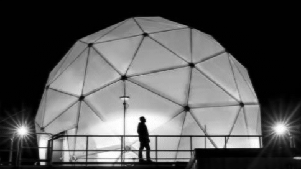http://www.rhci-online.net/radiogram/radiogram.htm

http://www.rhci-online.net/radiogram/radiogram.htm

RSID: <<2022-09-09T13:01Z MFSK-32 @ 15770000+1500>>
Welcome to program 271 of Shortwave Radiogram.
I'm Kim Andrew Elliott in Arlington, Virginia USA.
Here is the lineup for today's program, in MFSK modes as noted:
1:34 MFSK32: Program preview (now)
2:42 MFSK32: Why does Pluto's moon Charon have a reddish pole?*
8:19 MFSK64: MIT develops versatile satellite ground antenna*
13:54 MFSK64: This week's images*
28:38 MFSK32: Closing announcements
* with image(s)
Please send reception reports to radiogram@verizon.net
And visit http://swradiogram.net
We're on Twitter now: @SWRadiogram
From Phys.org:
A new explanation for the reddish north pole of Pluto's moon
Charon
by Bob Yirka
September 7, 2022
A trio of researchers at Purdue University has developed a new
theory to explain why Pluto's moon Charon has a reddish north
pole. In their paper published in the journal Nature
Communications, Stephanie Menten, Michael Sori and Ali Bramson,
describe their study of the reddish surfaces of many icy objects
in the Kuiper Belt, and how they might relate to Charon's reddish
pole.
Prior research has shown that many icy objects in the Kuiper belt
are partly or entirely covered in reddish brown material. Prior
research has also shown that the material is a kind of
tholin - compounds that are formed when organic chemicals are
showered with radiation. But that has raised the question of
where the organic compounds may have come from. In this new
effort, the researchers theorize that it comes from methane
released from cryovolcanoes.
To test their theory, the researchers turned to Pluto's moon
Charon, whose north pole is covered with tholin. They note that
prior research suggests that gases escaping from Pluto are
responsible for the reddish pole. But prior research has also
shown that the moon was once covered with a liquid ocean that
contained many materials, including methane.
As the ocean froze, the methane would have become trapped in the
ice, the researchers note. They note also that as the water
became pressurized, cracks would have formed, leading to
occasional eruptions. Such cryovolcanic eruptions, they suggest,
could have released some amount of methane gas. And if some of
that methane gas managed to drift all the way to the north pole,
it would have frozen and fallen to the surface. And if it fell to
the surface, it would have been subjected to millions of years of
radiation from the sun, making it turn red.
The researchers created simulations of methane molecules drifting
around in the Charon atmosphere, calculating how much methane
could have escaped under such a scenario and how much might have
made it to the north pole. They found that approximately 1000
billion metric tons of the gas could have made it to northern
pole - more than enough to create a red cap.
https://phys.org/news/2022-09-explanation-reddish-north-pole-pluto.html
Image: Accompanying photo of Charon ...
Sending Pic:189x172C;

Shortwave Radiogram now changes to MFSK64 ...
RSID: <<2022-09-09T13:08Z
MFSK-64 @
15770000+1500>>
From TechXplore:
Antenna enables advanced satellite communications testing
by Ariana Tantillo, Massachusetts Institute of Technology
On the rooftop of an MIT Lincoln Laboratory building sits a
38-foot-wide dome-shaped radio antenna enclosure, or radome.
Inside the climate-controlled environment, shielded from the New
England weather, a steel structure supports a 20,000-pound,
20-foot diameter satellite communications (SATCOM) antenna. The
antenna - called the Multi-Band Test Terminal (MBTT) - can rotate 15
degrees per second, completing a single revolution in 24 seconds.
At this speed, the MBTT can detect and track satellites in medium
and low Earth orbit (medium and low refer to the altitude at
which the satellites orbit the Earth).
Prior to the installation of the MBTT in 2017, the laboratory
relied on a variety of smaller antennas for SATCOM testing,
including the Over-the-Air Ka-band Test Terminal, or OTAKaTT.
Compared to the nearly eight-foot diameter OTAKaTT antenna, the
MBTT is seven times more sensitive. And unlike its predecessor,
the MBTT, as its name suggests, is designed to be easily
reconfigured to support multiple radio frequency (RF) bands used
for military and commercial satellite SATCOM systems.
"As a much larger, more powerful, and more flexible test asset
than OTAKaTT, the MBTT is a game-changer for enabling the
development of advanced SATCOM technology," says Brian Wolf, a
technical staff member in Lincoln Laboratory's Advanced Satcom
Systems and Operations Group.
Wolf was involved in the installation and initial commissioning
of the MBTT in 2017. He then led the MBTT through a rigorous
certification process with the U.S. Army Space and Missile
Defense Command, completed in 2019, demonstrating that the
transmit and receive performance of the antenna was sufficient
for it to operate on the Wideband Global SATCOM (WGS) system. A
constellation of 10 satellites owned and operated by the U.S.
Department of Defense, WGS provides high-data-rate connectivity
between various points on Earth. Since 2019, Wolf has served as
principal investigator on a project that owns the MBTT,
supporting the development of the U.S. Space Force's Protected
Anti-Jam Tactical SATCOM (PATS) capabilities.
"PATS is developing the capability to deliver protected tactical
waveform, or PTW, services over WGS, as well as over commercial
transponder satellites and new DoD satellites with dedicated
onboard PTW processing," says Wolf.
As Wolf explains, a waveform is the signal transmitted between
two modems when they are communicating, and PTW is a special kind
of waveform designed to provide highly secure, jamming-resistant
communications. Jamming refers to when communication signals are
interfered with - either accidentally by friendly forces (who, for
example, may have misconfigured their SATCOM equipment and are
transmitting at the wrong frequency) or intentionally by
adversaries seeking to prevent communications. Lincoln Laboratory
started developing PTW in 2011, contributing to the initial
design and system architecture. In the years since, the
laboratory has participated in prototyping and testing efforts to
help industry mature modems for processing the waveform.
"Our prototype PTW modems have been fielded to industry sites all
over the country so vendors can test against them as they develop
PTW systems that will be deployed in the real world," says Wolf.
The initial operating capability for PTW services over WGS is
anticipated for 2024.
Staff originally conceived the MBTT as a test asset for PTW.
Directly underneath the MBTT is a PTW development lab, where
researchers can run connections directly to the antenna to
perform PTW testing.
One of the design goals for PTW is the flexibility to operate on
a wide range of RF bands relevant to satellite communications.
That means researchers need a way to test PTW on these bands. The
MBTT was designed to support four commonly used bands for SATCOM
that span frequencies from 7 GHz to 46 GHz: X, Ku, Ka, and Q.
However, the MBTT can be adapted in the future to support other
bands through the design of additional antenna feeds, the
equipment connecting the antenna to the RF transmitter and
receiver.
To switch between the different supported RF bands, the MBTT must
be reconfigured with a new antenna feed, which emits signals onto
and collects signals from the antenna dish, and RF processing
components. When not in use, antenna feeds and other RF
components are stored in the MBTT command center, located
underneath the main platform of the antenna. The feeds come in a
range of sizes, with the largest registering six feet in length
and weighing nearly 200 pounds.
To swap out one feed for another, a crane inside the radome is
used to lift up, unbolt, and remove the old feed; a second crane
then lifts the new feed up into place. Not only does the feed on
the front of the antenna need to be replaced, but all of the RF
processing components on the back of the antenna - such as the
high-power amplifier for boosting satellite signals and the
downconverter for converting RF signals to a lower frequency more
suitable for digital processing - also need to be replaced. A team
of skilled technicians can complete this process in four to six
hours. Before scientists can run any tests, the technicians must
calibrate the new feed to ensure it is operating properly.
Typically, they point the antenna onto a satellite known to
broadcast at a specific frequency and collect receive
measurements, and point the antenna straight up into free space
to collect transmission measurements.
...
Full text:
https://techxplore.com/news/2022-09-antenna-enables-advanced-satellite.html
Image: The radome protecting the Multi-Band Test Terminal on an
MIT Lincoln Laboratory building rooftop.
Sending Pic:301x169;

This is Shortwave Radiogram in MFSK64
Please send your reception report to radiogram@verizon.net
This week's images ...
Scene from the Fairview fire near Hemet, California.
https://bit.ly/3x5AY9f ...
Sending Pic:155x205C;

Flamingos walk through a brine pond in the National Flamingo
Reserve near San Pedro de Atacama, Chile, August 27.
https://bit.ly/3qnfVey ...
Sending Pic:152x200C;

A statue of a Kansa warrior titled "Ad Astra," atop the Kansas
Statehouse silhouetted against the setting moon in Topeka,
Kansas.
https://bit.ly/3qlmcqU ...
Sending Pic:178x194C;
Julian Alper: "While out walking recently on Mount Arbel, near
the Sea of Galilee, on a beautiful and hot summer day, I saw this
beautiful swallowtail. I was reminded of Keats, who wrote: 'I
almost wish we were butterflies and liv'd but three summer
days.'" https://bbc.in/3RuXY9Q ...
Sending Pic:196x190C;

"The most #minnesota aurora pic ever!" September 4.
https://bit.ly/3Db2GFc ...
Sending Pic:213x124C;

Sunset at Gullane beach, Scotland.
https://bbc.in/3Rr82Rb ...
Sending Pic:204x151C;

Every year on August 28, sunrise aligns with the railroad track
in Homer, Illinois.
https://bit.ly/3KTh3jv ...
Sending Pic:139x207C;

Our painting of the week is "September Glads" (gladiolas) by
Alexandrya Eaton.
https://bit.ly/3BnkUlv ...
Sending Pic:108x220C;

Shortwave Radiogram returns to MFSK32 ...
RSID: <<2022-09-09T13:28Z
MFSK-32 @
15770000+1500>>
This is Shortwave Radiogram in MFSK32 ...
Shortwave Radiogram is transmitted
by:
WRMI, Radio Miami International, wrmi.net
and
WINB Shortwave, winb.com
Please send reception reports to
radiogram@verizon.net
And visit http://swradiogram.net
Twitter:
@SWRadiogram or twitter.com/swradiogram
I'm Kim Elliott. Please join us for the next Shortwave
Radiogram.
|
Closing music SWRG#271 - WINB - Version: https://www.midomi.com/Track?trackID=100740877369418740&song=your-good-thing-(is-about-to-end)
Mable John -
Your Good Thing (Is About to End)
Your Good Thing [Is About To End] • 2005
Closing music SWRG#271 - WRMI - Version: https://www.midomi.com/Track?trackID=100652156128082424&song=sing%5Bcommonwealth-version%5D Gary Barlow, Military Wives, The Commonwealth Band Sing[Commonwealth Version] Sing • 2012
|
http://www.rhci-online.net/radiogram/radiogram.htm
|
QTH: |
D-06193 Petersberg (Germany/Germania) |
|
|
Ant.: |
Dipol for 40m-Band & Boomerang Antenna 11m-Band |
|
|
RX for RF: |
FRG-100B + IF-mixer & ICOM IC-R75 + IF-mixer |
|
|
Software IF: |
con STUDIO1 - Software italiano per SDR [S-AM-USB/LSB] + beta 11 Version 2.80 (August 21, 2018) - for scheduled IF-recording |
|
|
Software AF: |
Fldigi-4.0.18 + flmsg-4.0.7 images-fldigifiles on homedrive.lnk |
|
|
OS: |
German XP-SP3 with support for asian languages |
German W7 32bit + 64bit |
|
PC: |
MEDION Titanium 8008 (since 2003) [ P4 - 2,6 GHz] |
MSI-CR70-2MP345W7 (since2014) [i5 -P3560 ( 2 x 2,6GHz) ] |
http://wiki.radioreference.com/index.php/Decoding_the_SW_Radiogram_Broadcasts
https://www.qsl.net/ve7vv/Files/Digital%20Modes.pdf
RSID: <<2022-09-11T01:30Z
MFSK-64 @
5960000+1500>>
Sending Pic:204x238;

bit.ly/3RlqhXX
youtu.be/OS1LFGGGazc
Please report your decode to
themightykbc@gmail.com

RSID: <<2022-09-08T02:49Z
MFSK-64 @
5850000+1500>>
This Is A Music Show #182
08 September 2022
0200-0300UTC Thursday on 5850 kHz
via WRMI, Okeechobee USA
***ALSO***
TIAnExpressMS w/ Radio Northern Europe International
via Channel 292 in Germany, mainly on 6070 kHz.
Broadcast various dates/times/freqs. Check the schedule here:
https://www.channel292.de/
https://rnei.org/
----------------------------------------
PLAYLIST
Jack Mooney Quintet - Stay Out Of The South
-----
The Unifics - It's All Over
Zalatnay Sarolta - Késő Esti Órán
David Rose - Workin' On A Groovy Thing
-----
Bardeux - Bleeding Heart
Ramsey Lewis - 7-11
-----
Run D.M.C. - Sucker MCs (Krush Groove 1)
Whodini - Echo Scratch
-----
Saka Acquaye And His African Ensemble - Congo Beat
Eberhard Weber - The Colours Of Chloë
-----
Marie Josee Simard - The Typewriter
-----
THIS DATA w/ Bert Kaempfert - Take Me
-----
Peggy Lee - Till There Was You
----------------------------------------
TIAMS Website:
https://thisisamusicshow.com
Go here for show archives + official shop!
-----
Please send reception reports/comments:
thisisamusicshow@gmail.com
Follow TIAMS on Twitter:
www.twitter.com/ThisIsAMusicSho/
------
Thanks for listening!
--YOUR HOST--
EOM
RSID: <<2022-09-08T02:50Z
MFSK-64 @
5850000+1500>>
Sending Pic:300x300Cp4;


|
RSID: <<2022-09-08T01:25Z MFSK-64 @ 5850000+1500>>
-
--- RNEI Show # Playlist ---
|
|
RNEI 33 Playlist, September 2022 - for 🌴 WRMI 🌴 (Spotify Stream numbers included) |
||||||
|
|
|
flag |
Spotify |
MIDOMI |
YT date |
YT-link |
| 1. | Emma Nicoline - Står Imod | 🇩🇰 | (52.2k) | 2022-02-24 | https://youtu.be/KmstXYEnG7o | |
| 2. | Pikekyss - Må jeg vite alt? | 🇳🇴 | (75.7k) | 2022-01-27 | https://youtu.be/VSX94sbMQI8 | |
| 3. | Honey - What Now https://scandipop.co.uk | 🇸🇪 | (4885) | 2022-08-26 | https://youtu.be/8fcYCas7lZM | |
| 4. | Sisterix - Wasteland | 🇮🇪 | (<1k) | 2022-05-18 | https://youtu.be/8b6Wi5b97Jg | |
| 5. | Kardemimmit - Myötätuuli | 🇫🇮 | (47k) | 2018-02-27 | https://youtu.be/YSHqvWtZ0_I | |
| 6. | Marína Ósk & Rebekka Blöndal - Góða kíkt'í kaffi | 🇮🇸 | (19.2k) | 2022-08-15 | https://youtu.be/olUnz2xj7go | |
| 7. | Sofiloud & Gucci Caliente - The Hookup | 🇳🇴 | (108k) | 2021-11-25 | https://youtu.be/pVbayA00dgI | |
| Mamma's Mest Metal | ||||||
| 8. | The Poodles - Set Fire to the Rain | 🇸🇪 | (349k) | 2018-01-17 | https://youtu.be/88NzfmEPsP0 | |
| 9. | Treat - Do Your Own Stunts | 🇸🇪 | (158k) | 2016-04-04 | https://youtu.be/5pBhrFWevtI | |
| 10. | SOILWORK - Full Moon Shoals | 🇸🇪 | (2.2m) | 2018-10-26 | https://youtu.be/AHZhl_pniUY | |
| 11. | Árstíðir - Shine | 🇮🇸 | (113k) | 2015-04-27 | https://youtu.be/uplalXrTfso | |
| Stephen's Feature - Garmarna 🇸🇪 | ||||||
| 12. | Garmarna - Den Bortsålda | 🇸🇪 | (75.3k) | 2012-04-11 | https://youtu.be/7j9HTcl3khs | |
| 13. | Garmarna - Nåden | 🇸🇪 | (1.6m) | 2016-06-02 | https://youtu.be/Si_yzHmVa9w | |
| 14. | Garmarna - Ramunder | 🇸🇪 | (708k) | 2020-08-26 | https://youtu.be/eYsMuNLueNk | |